MatConvNet
Convolutional Neural Networks for MATLAB
Andrea Vedaldi
Karel Lenc
Ankush Gupta
i
�
ii
Abstract
MatConvNet is an implementation of Convolutional Neural Networks (CNNs)
for MATLAB. The toolbox is designed with an emphasis on simplicity and flexibility.
It exposes the building blocks of CNNs as easy-to-use MATLAB functions, providing
routines for computing linear convolutions with filter banks, feature pooling, and many
more. In this manner, MatConvNet allows fast prototyping of new CNN architec-
tures; at the same time, it supports efficient computation on CPU and GPU allowing
to train complex models on large datasets such as ImageNet ILSVRC. This document
provides an overview of CNNs and how they are implemented in MatConvNet and
gives the technical details of each computational block in the toolbox.
�
Contents
1 Introduction to MatConvNet
1.1 Getting started . . . . . . . . . . . . . . . . . . . . . . . . . . . . . . . . . .
1.2 MatConvNet at a glance
. . . . . . . . . . . . . . . . . . . . . . . . . . .
1.3 Documentation and examples
. . . . . . . . . . . . . . . . . . . . . . . . . .
1.4 Speed . . . . . . . . . . . . . . . . . . . . . . . . . . . . . . . . . . . . . . .
1.5 Acknowledgments . . . . . . . . . . . . . . . . . . . . . . . . . . . . . . . . .
2 Neural Network Computations
2.1 Overview . . . . . . . . . . . . . . . . . . . . . . . . . . . . . . . . . . . . . .
2.2 Network structures . . . . . . . . . . . . . . . . . . . . . . . . . . . . . . . .
2.2.1
Sequences . . . . . . . . . . . . . . . . . . . . . . . . . . . . . . . . .
2.2.2 Directed acyclic graphs . . . . . . . . . . . . . . . . . . . . . . . . . .
2.3 Computing derivatives with backpropagation . . . . . . . . . . . . . . . . . .
2.3.1 Derivatives of tensor functions . . . . . . . . . . . . . . . . . . . . . .
2.3.2 Derivatives of function compositions
. . . . . . . . . . . . . . . . . .
2.3.3 Backpropagation networks . . . . . . . . . . . . . . . . . . . . . . . .
2.3.4 Backpropagation in DAGs . . . . . . . . . . . . . . . . . . . . . . . .
2.3.5 DAG backpropagation networks . . . . . . . . . . . . . . . . . . . . .
3 Wrappers and pre-trained models
3.1 Wrappers
. . . . . . . . . . . . . . . . . . . . . . . . . . . . . . . . . . . . .
SimpleNN . . . . . . . . . . . . . . . . . . . . . . . . . . . . . . . . .
3.1.1
3.1.2 DagNN . . . . . . . . . . . . . . . . . . . . . . . . . . . . . . . . . .
3.2 Pre-trained models . . . . . . . . . . . . . . . . . . . . . . . . . . . . . . . .
3.3 Learning models . . . . . . . . . . . . . . . . . . . . . . . . . . . . . . . . . .
3.4 Running large scale experiments . . . . . . . . . . . . . . . . . . . . . . . . .
4 Computational blocks
4.1 Convolution . . . . . . . . . . . . . . . . . . . . . . . . . . . . . . . . . . . .
4.2 Convolution transpose (deconvolution)
. . . . . . . . . . . . . . . . . . . . .
4.3 Spatial pooling . . . . . . . . . . . . . . . . . . . . . . . . . . . . . . . . . .
4.4 Activation functions
. . . . . . . . . . . . . . . . . . . . . . . . . . . . . . .
4.5 Spatial bilinear resampling . . . . . . . . . . . . . . . . . . . . . . . . . . . .
4.6 Normalization . . . . . . . . . . . . . . . . . . . . . . . . . . . . . . . . . . .
. . . . . . . . . . . . . . . . . .
4.6.1 Local response normalization (LRN)
1
2
4
5
6
7
9
9
10
10
11
12
12
13
14
15
18
21
21
21
21
22
23
23
25
25
27
29
29
30
30
30
iii
�
iv
CONTENTS
4.6.2 Batch normalization . . . . . . . . . . . . . . . . . . . . . . . . . . .
Spatial normalization . . . . . . . . . . . . . . . . . . . . . . . . . . .
4.6.3
4.6.4
Softmax . . . . . . . . . . . . . . . . . . . . . . . . . . . . . . . . . .
4.7 Categorical losses . . . . . . . . . . . . . . . . . . . . . . . . . . . . . . . . .
4.7.1 Classification losses . . . . . . . . . . . . . . . . . . . . . . . . . . . .
4.7.2 Attribute losses . . . . . . . . . . . . . . . . . . . . . . . . . . . . . .
4.8 Comparisons . . . . . . . . . . . . . . . . . . . . . . . . . . . . . . . . . . . .
p-distance . . . . . . . . . . . . . . . . . . . . . . . . . . . . . . . . .
4.8.1
5 Geometry
5.1 Preliminaries
5.2 Simple filters
. . . . . . . . . . . . . . . . . . . . . . . . . . . . . . . . . . .
. . . . . . . . . . . . . . . . . . . . . . . . . . . . . . . . . . .
5.2.1 Pooling in Caffe . . . . . . . . . . . . . . . . . . . . . . . . . . . . . .
5.3 Convolution transpose . . . . . . . . . . . . . . . . . . . . . . . . . . . . . .
5.4 Transposing receptive fields
. . . . . . . . . . . . . . . . . . . . . . . . . . .
5.5 Composing receptive fields . . . . . . . . . . . . . . . . . . . . . . . . . . . .
5.6 Overlaying receptive fields . . . . . . . . . . . . . . . . . . . . . . . . . . . .
6 Implementation details
6.1 Convolution . . . . . . . . . . . . . . . . . . . . . . . . . . . . . . . . . . . .
6.2 Convolution transpose . . . . . . . . . . . . . . . . . . . . . . . . . . . . . .
6.3 Spatial pooling . . . . . . . . . . . . . . . . . . . . . . . . . . . . . . . . . .
. . . . . . . . . . . . . . . . . . . . . . . . . . . . . . .
6.4 Activation functions
6.4.1 ReLU . . . . . . . . . . . . . . . . . . . . . . . . . . . . . . . . . . .
6.4.2
Sigmoid . . . . . . . . . . . . . . . . . . . . . . . . . . . . . . . . . .
6.5 Spatial bilinear resampling . . . . . . . . . . . . . . . . . . . . . . . . . . . .
6.6 Normalization . . . . . . . . . . . . . . . . . . . . . . . . . . . . . . . . . . .
6.6.1 Local response normalization (LRN)
. . . . . . . . . . . . . . . . . .
6.6.2 Batch normalization . . . . . . . . . . . . . . . . . . . . . . . . . . .
Spatial normalization . . . . . . . . . . . . . . . . . . . . . . . . . . .
6.6.3
6.6.4
Softmax . . . . . . . . . . . . . . . . . . . . . . . . . . . . . . . . . .
6.7 Categorical losses . . . . . . . . . . . . . . . . . . . . . . . . . . . . . . . . .
6.7.1 Classification losses . . . . . . . . . . . . . . . . . . . . . . . . . . . .
6.7.2 Attribute losses . . . . . . . . . . . . . . . . . . . . . . . . . . . . . .
6.8 Comparisons . . . . . . . . . . . . . . . . . . . . . . . . . . . . . . . . . . . .
p-distance . . . . . . . . . . . . . . . . . . . . . . . . . . . . . . . . .
6.8.1
Bibliography
30
31
31
31
32
33
34
34
37
37
38
38
40
41
42
42
43
43
44
45
45
45
46
46
46
46
47
48
48
49
49
49
50
50
51
�
Chapter 1
Introduction to MatConvNet
MatConvNet is a MATLAB toolbox implementing Convolutional Neural Networks (CNN)
for computer vision applications. Since the breakthrough work of [7], CNNs have had a
major impact in computer vision, and image understanding in particular, essentially replacing
traditional image representations such as the ones implemented in our own VLFeat [11] open
source library.
While most CNNs are obtained by composing simple linear and non-linear filtering op-
erations such as convolution and rectification, their implementation is far from trivial. The
reason is that CNNs need to be learned from vast amounts of data, often millions of images,
requiring very efficient implementations. As most CNN libraries, MatConvNet achieves
this by using a variety of optimizations and, chiefly, by supporting computations on GPUs.
Numerous other machine learning, deep learning, and CNN open source libraries exist.
To cite some of the most popular ones: CudaConvNet,1 Torch,2 Theano,3 and Caffe4. Many
of these libraries are well supported, with dozens of active contributors and large user bases.
Therefore, why creating yet another library?
The key motivation for developing MatConvNet was to provide an environment par-
ticularly friendly and efficient for researchers to use in their investigations.5 MatConvNet
achieves this by its deep integration in the MATLAB environment, which is one of the most
popular development environments in computer vision research as well as in many other areas.
In particular, MatConvNet exposes as simple MATLAB commands CNN building blocks
such as convolution, normalisation and pooling (chapter 4); these can then be combined and
extended with ease to create CNN architectures. While many of such blocks use optimised
CPU and GPU implementations written in C++ and CUDA (section section 1.4), MATLAB
native support for GPU computation means that it is often possible to write new blocks
in MATLAB directly while maintaining computational efficiency. Compared to writing new
CNN components using lower level languages, this is an important simplification that can
significantly accelerate testing new ideas. Using MATLAB also provides a bridge towards
1https://code.google.com/p/cuda-convnet/
2http://cilvr.nyu.edu/doku.php?id=code:start
3http://deeplearning.net/software/theano/
4http://caffe.berkeleyvision.org
5While from a user perspective MatConvNet currently relies on MATLAB, the library is being devel-
oped with a clean separation between MATLAB code and the C++ and CUDA core; therefore, in the future
the library may be extended to allow processing convolutional networks independently of MATLAB.
1
�
2
CHAPTER 1.
INTRODUCTION TO MATCONVNET
other areas; for instance, MatConvNet was recently used by the University of Arizona in
planetary science, as summarised in this NVIDIA blogpost.6
MatConvNet can learn large CNN models such AlexNet [7] and the very deep net-
works of [9] from millions of images. Pre-trained versions of several of these powerful models
can be downloaded from the MatConvNet home page7. While powerful, MatConvNet
remains simple to use and install. The implementation is fully self-contained, requiring only
MATLAB and a compatible C++ compiler (using the GPU code requires the freely-available
CUDA DevKit and a suitable NVIDIA GPU). As demonstrated in fig. 1.1 and section 1.1,
it is possible to download, compile, and install MatConvNet using three MATLAB com-
mands. Several fully-functional examples demonstrating how small and large networks can
be learned are included. Importantly, several standard pre-trained network can be immedi-
ately downloaded and used in applications. A manual with a complete technical description
of the toolbox is maintained along with the toolbox.8 These features make MatConvNet
useful in an educational context too.9
MatConvNet is open-source released under a BSD-like license. It can be downloaded
from http://www.vlfeat.org/matconvnet as well as from GitHub.10.
1.1 Getting started
MatConvNet is simple to install and use. fig. 1.1 provides a complete example that clas-
sifies an image using a latest-generation deep convolutional neural network. The example
includes downloading MatConvNet, compiling the package, downloading a pre-trained CNN
model, and evaluating the latter on one of MATLAB’s stock images.
The key command in this example is vl_simplenn, a wrapper that takes as input the
CNN net and the pre-processed image im_ and produces as output a structure res of results.
This particular wrapper can be used to model networks that have a simple structure, namely
a chain of operations. Examining the code of vl_simplenn (edit vl_simplenn in MatCon-
vNet) we note that the wrapper transforms the data sequentially, applying a number of
MATLAB functions as specified by the network configuration. These function, discussed in
detail in chapter 4, are called “building blocks” and constitute the backbone of MatCon-
vNet.
While most blocks implement simple operations, what makes them non trivial is their
efficiency (section 1.4) as well as support for backpropagation (section 2.3) to allow learning
CNNs. Next, we demonstrate how to use one of such building blocks directly. For the sake of
the example, consider convolving an image with a bank of linear filters. Start by reading an
image in MATLAB, say using im = single(imread('peppers.png')), obtaining a H × W × D
array im, where D = 3 is the number of colour channels in the image. Then create a bank
of K = 16 random filters of size 3 × 3 using f = randn(3,3,3,16,'single'). Finally, convolve the
6http://devblogs.nvidia.com/parallelforall/deep-learning-image-understanding-planetary-science/
7http://www.vlfeat.org/matconvnet/
8http://www.vlfeat.org/matconvnet/matconvnet-manual.pdf
9An example laboratory experience based on MatConvNet can be downloaded from http://www.
robots.ox.ac.uk/~vgg/practicals/cnn/index.html.
10http://www.github.com/matconvnet
�
1.1. GETTING STARTED
3
'matconvnet−1.0−beta12.tar.gz']) ;
% install and compile MatConvNet (run once)
untar(['http://www.vlfeat.org/matconvnet/download/' ...
cd matconvnet−1.0−beta12
run matlab/vl_compilenn
% download a pre−trained CNN from the web (run once)
urlwrite(...
'http://www.vlfeat.org/matconvnet/models/imagenet−vgg−f.mat', ...
'imagenet−vgg−f.mat') ;
% setup MatConvNet
run matlab/vl_setupnn
% load the pre−trained CNN
net = load('imagenet−vgg−f.mat') ;
% load and preprocess an image
im = imread('peppers.png') ;
im_ = imresize(single(im), net.meta.normalization.imageSize(1:2)) ;
im_ = im_ − net.meta.normalization.averageImage ;
% run the CNN
res = vl_simplenn(net, im_) ;
% show the classification result
scores = squeeze(gather(res(end).x)) ;
[bestScore, best] = max(scores) ;
figure(1) ; clf ; imagesc(im) ;
title(sprintf('%s (%d), score %.3f',...
net.classes.description{best}, best, bestScore)) ;
Figure 1.1: A complete example including download, installing, compiling and running Mat-
ConvNet to classify one of MATLAB stock images using a large CNN pre-trained on
ImageNet.
bell pepper (946), score 0.704�
4
CHAPTER 1.
INTRODUCTION TO MATCONVNET
image with the filters by using the command y = vl_nnconv(x,f,[]). This results in an array
y with K channels, one for each of the K filters in the bank.
While users are encouraged to make use of the blocks directly to create new architectures,
MATLAB provides wrappers such as vl_simplenn for standard CNN architectures such as
AlexNet [7] or Network-in-Network [8]. Furthermore, the library provides numerous examples
(in the examples/ subdirectory), including code to learn a variety of models on the MNIST,
CIFAR, and ImageNet datasets. All these examples use the examples/cnn_train training
code, which is an implementation of stochastic gradient descent (section 3.3). While this
training code is perfectly serviceable and quite flexible, it remains in the examples/ subdirec-
tory as it is somewhat problem-specific. Users are welcome to implement their optimisers.
1.2 MatConvNet at a glance
MatConvNet has a simple design philosophy. Rather than wrapping CNNs around complex
layers of software, it exposes simple functions to compute CNN building blocks, such as linear
convolution and ReLU operators, directly as MATLAB commands. These building blocks are
easy to combine into complete CNNs and can be used to implement sophisticated learning
algorithms. While several real-world examples of small and large CNN architectures and
training routines are provided, it is always possible to go back to the basics and build your
own, using the efficiency of MATLAB in prototyping. Often no C coding is required at all
to try new architectures. As such, MatConvNet is an ideal playground for research in
computer vision and CNNs.
MatConvNet contains the following elements:
• CNN computational blocks. A set of optimized routines computing fundamental
building blocks of a CNN. For example, a convolution block is implemented by
y=vl_nnconv(x,f,b) where x is an image, f a filter bank, and b a vector of biases (sec-
tion 4.1). The derivatives are computed as [dzdx,dzdf,dzdb] = vl_nnconv(x,f,b,dzdy)
where dzdy is the derivative of the CNN output w.r.t y (section 4.1). chapter 4 de-
scribes all the blocks in detail.
• CNN wrappers. MatConvNet provides a simple wrapper, suitably invoked by
vl_simplenn, that implements a CNN with a linear topology (a chain of blocks). It also
provides a much more flexible wrapper supporting networks with arbitrary topologies,
encapsulated in the dagnn.DagNN MATLAB class.
• Example applications. MatConvNet provides several examples of learning CNNs with
stochastic gradient descent and CPU or GPU, on MNIST, CIFAR10, and ImageNet
data.
• Pre-trained models. MatConvNet provides several state-of-the-art pre-trained CNN
models that can be used off-the-shelf, either to classify images or to produce image
encodings in the spirit of Caffe or DeCAF.
�
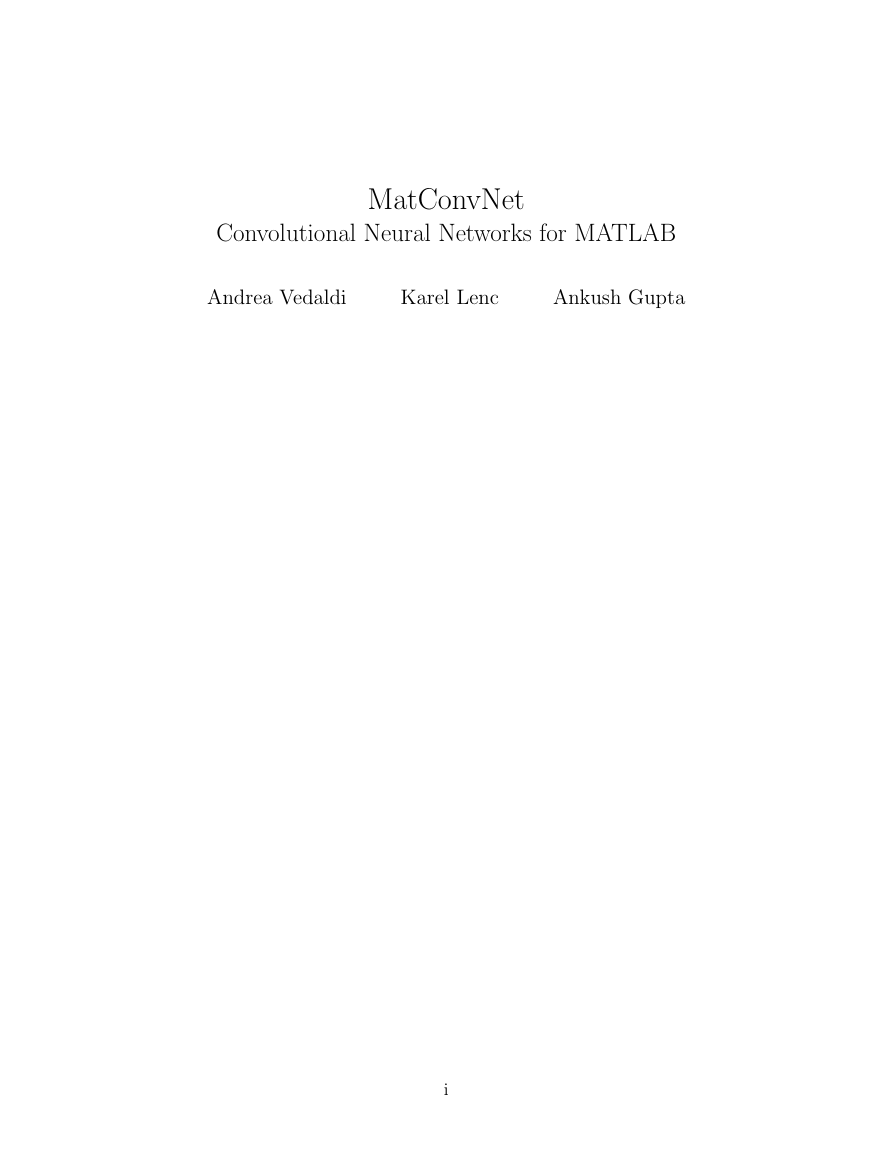
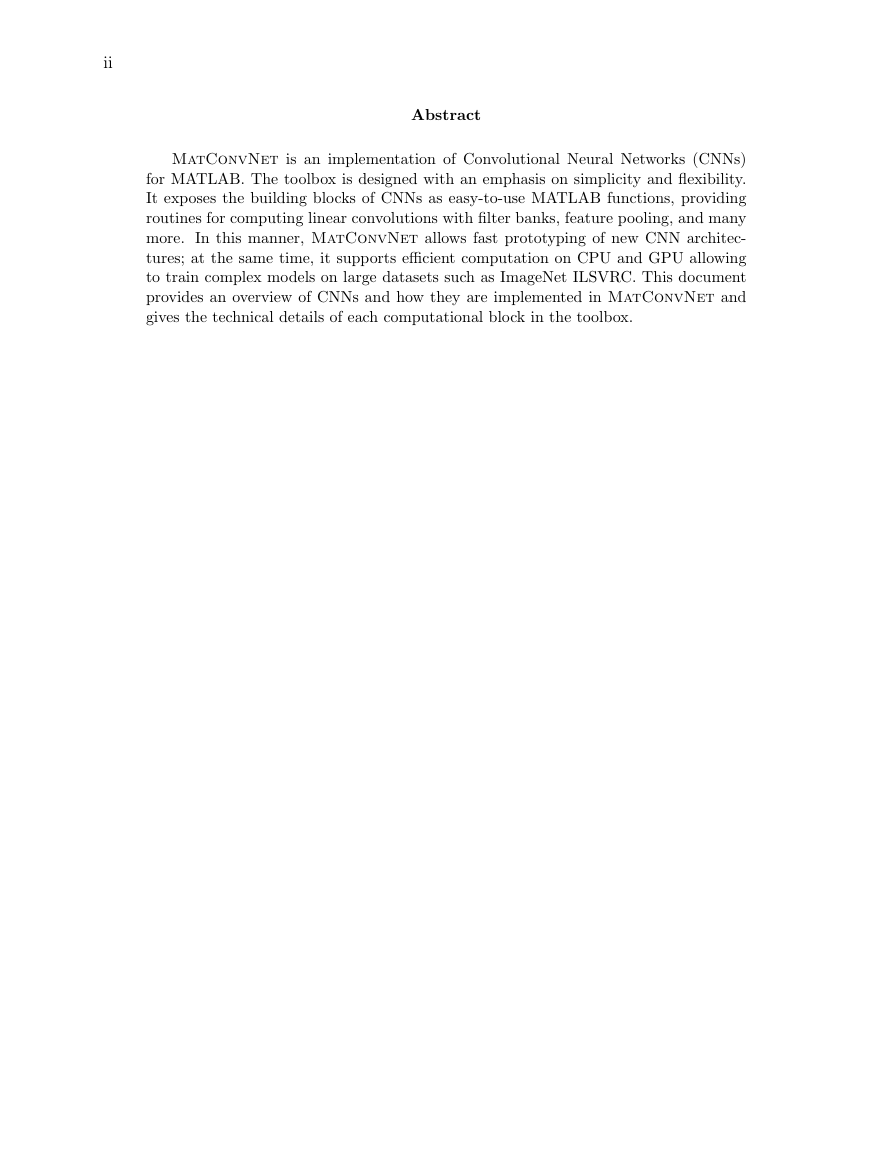
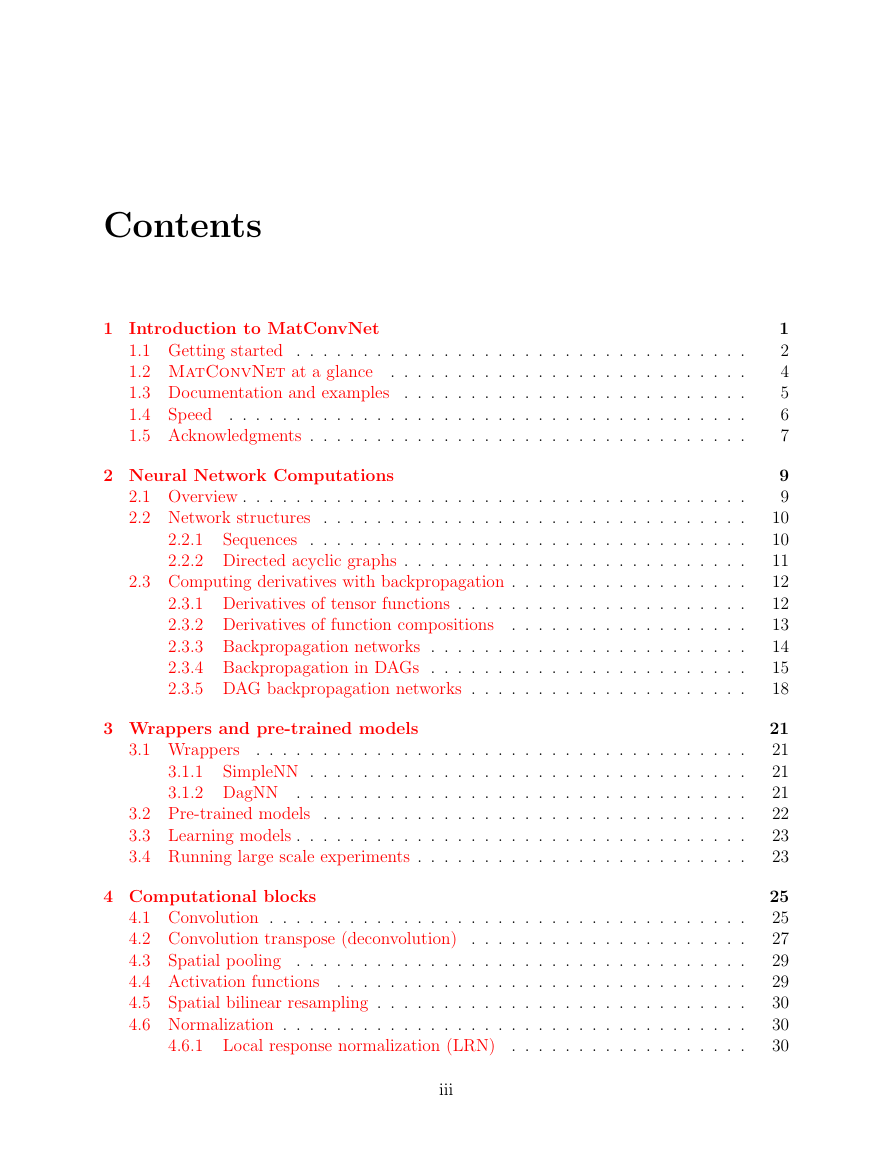
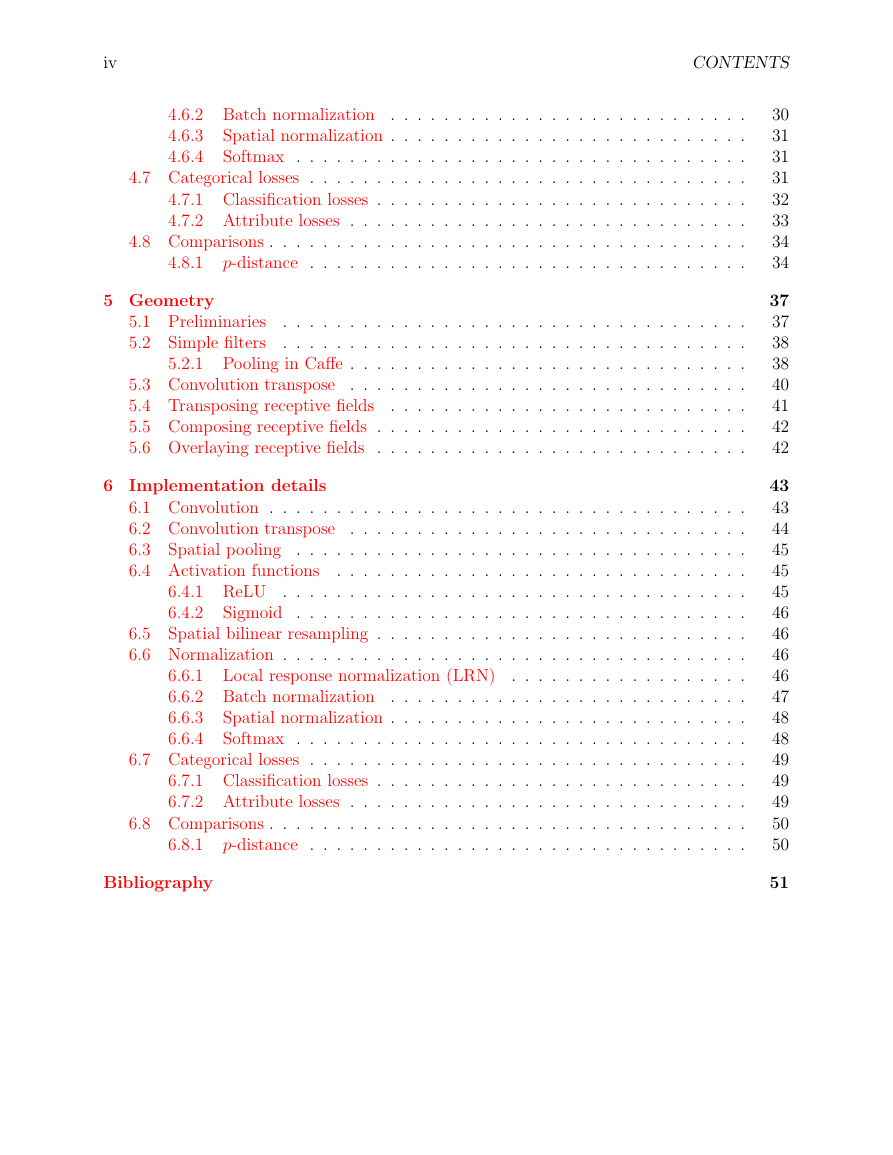



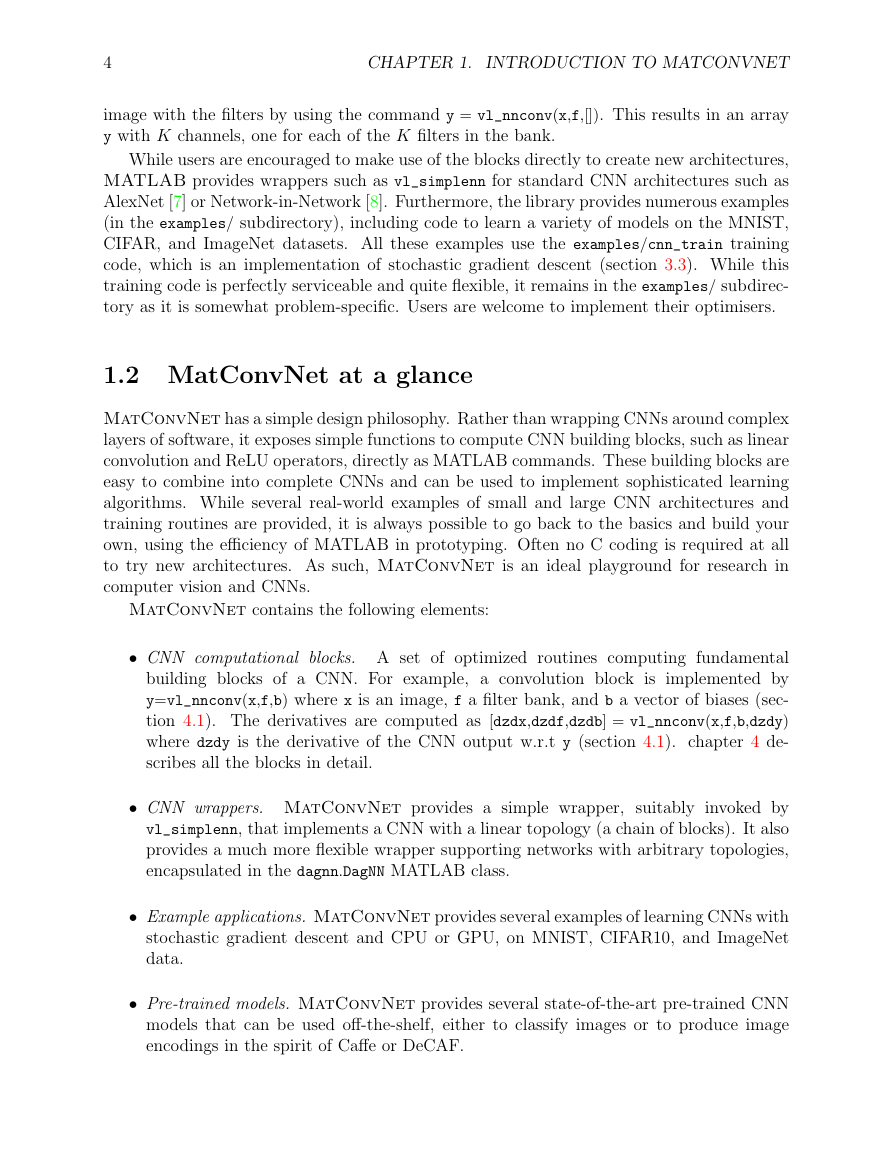








 2023年江西萍乡中考道德与法治真题及答案.doc
2023年江西萍乡中考道德与法治真题及答案.doc 2012年重庆南川中考生物真题及答案.doc
2012年重庆南川中考生物真题及答案.doc 2013年江西师范大学地理学综合及文艺理论基础考研真题.doc
2013年江西师范大学地理学综合及文艺理论基础考研真题.doc 2020年四川甘孜小升初语文真题及答案I卷.doc
2020年四川甘孜小升初语文真题及答案I卷.doc 2020年注册岩土工程师专业基础考试真题及答案.doc
2020年注册岩土工程师专业基础考试真题及答案.doc 2023-2024学年福建省厦门市九年级上学期数学月考试题及答案.doc
2023-2024学年福建省厦门市九年级上学期数学月考试题及答案.doc 2021-2022学年辽宁省沈阳市大东区九年级上学期语文期末试题及答案.doc
2021-2022学年辽宁省沈阳市大东区九年级上学期语文期末试题及答案.doc 2022-2023学年北京东城区初三第一学期物理期末试卷及答案.doc
2022-2023学年北京东城区初三第一学期物理期末试卷及答案.doc 2018上半年江西教师资格初中地理学科知识与教学能力真题及答案.doc
2018上半年江西教师资格初中地理学科知识与教学能力真题及答案.doc 2012年河北国家公务员申论考试真题及答案-省级.doc
2012年河北国家公务员申论考试真题及答案-省级.doc 2020-2021学年江苏省扬州市江都区邵樊片九年级上学期数学第一次质量检测试题及答案.doc
2020-2021学年江苏省扬州市江都区邵樊片九年级上学期数学第一次质量检测试题及答案.doc 2022下半年黑龙江教师资格证中学综合素质真题及答案.doc
2022下半年黑龙江教师资格证中学综合素质真题及答案.doc